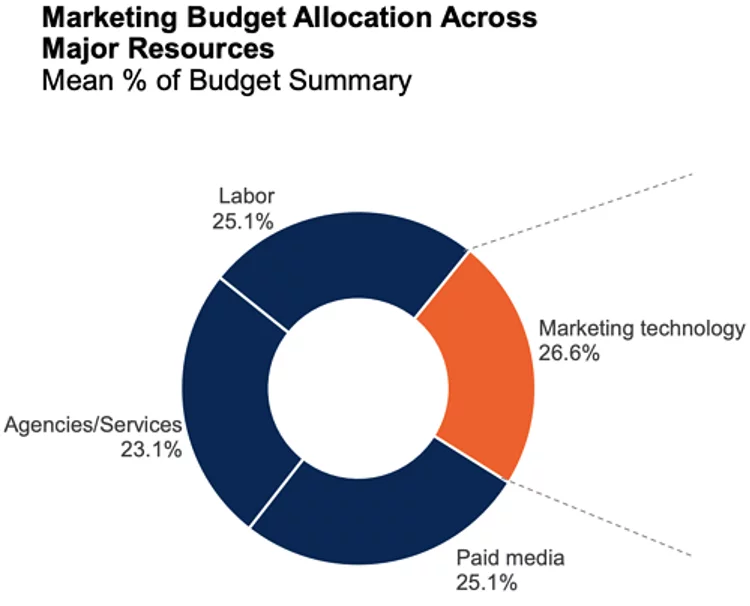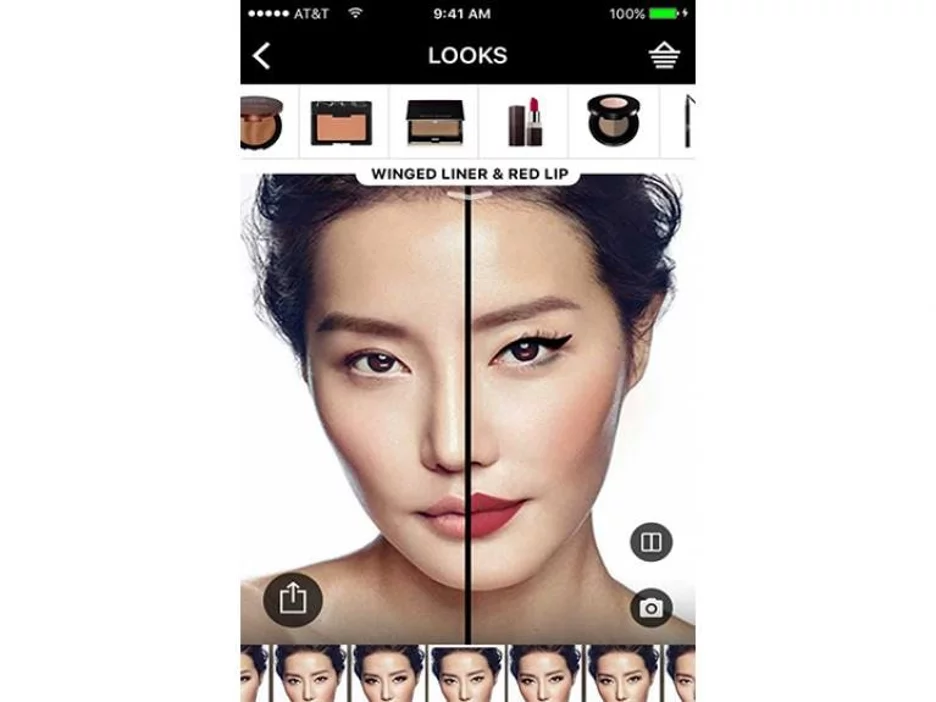As a brand or marketer, I’m sure you’ve used plenty of MarTech tools to make your efforts justice. MarTech tools and trends can keep your prospects moving further down the sales funnel while being satisfied with the offers and benefits they get.

(Source)
And as the stat above shows, the marketing world is already aware of how using a good chunk of the marketing budget towards MarTech products can benefit them in the long run. But using Artificial Intelligence to market your business and optimizing for voice search is sometimes not enough.
Marketers are constantly on the move, trying to come up with new things that could stir the pot and get their brand the number of customers they need to see. However, sometimes investing in the newest technology does not mean bettering your marketing techniques altogether.
MarTech: What to Invest In
Before diving into the latest Marketing Technology, it’s important to clarify something: Consumers engage with brands just by looking up a keyword or two. And since user intent is versatile, a brand’s use of MarTech should also be ready to adapt to new data.
Investing in the right MarTech products and services can help brands transform their marketing game. However, before you do so, you will need to understand some of MarTech’s innovations for 2022 and beyond.
Email Marketing and Marketing Automation
Email marketing is not something new – as a matter of fact, email marketing has been around since 1978, when the first email blast was sent. However, things have changed a lot since and will keep improving as time goes by.
Nowadays, the best email newsletter software is equipped with AI technology. This allows marketers to create tailor-made messages that stem from a user’s behavior. This type of email newsletter feels natural and organic, and users almost expect to see this content in their inbox.
AI technology will keep advancing, giving email marketing the opportunity to be more refined and able to adjust to each customer’s preference and needs. Customer data will be the driving force behind personalization and segmentation. As a matter of fact, as AI advances, marketers will be able to create segments so small that they will correspond to a user’s experience on a one-on-one basis.
AI in email marketing platforms will also give marketers the ability to predict a user’s desires and suggest just the right thing at the right time in terms of purchase.
The Use of Big Data on the Rise
As mentioned above, AI needs data to give the best possible results. This means that big data platforms will go beyond 2022 and will become a MarTech staple.
Content writing services, eCommerce platforms, and SaaS brands all use analytics to monitor website, content, and social media performance and understand how their brand influences and can be influenced by their customers. Important metrics like Customer Lifetime Value (CLTV), Churn Rate (CR), or Customer Retention Rate (CRR) can be viewed as graphs. And can also be predicted accurately through big data.
AI and machine learning can aid marketers and brands with predicting changes in trends – and, by extension, how and why customers and prospects will spend their money. This, in turn, will help them create a go-to-market strategy that will contain more customer-centric procedures, better pricing, and increased customer loyalty.
Using user data might sound a little ambiguous in 2022, and data leaks are one of the customers’ primary concerns, but using their data and being transparent about it will allow you to better your strategy.
Big data will show you the platforms your users frequent, the content they like to interact with, and the pricing and offers they’re willing to take advantage of. That way, when you’re suggesting a product or service, your brand will always be spot-on.
Big data platforms are a valuable tool for understanding a user’s behavior and creating an adaptable strategy while saving time and resources for your teams.
Virtual Reality, Augmented Reality, and Internet of Things
Virtual reality (VR) is one of the MarTech trends that will be indispensable in the following years. Brands that can adapt to VR have already won over a great chunk of their marketing audience. Especially seeing as users always chase after new, experimental content tactics and marketing strategies.
VR marketing is something that most brands haven’t adapted to yet. However, the use of its little cousin, Augmented Reality (AR), is on the rise. AR is slightly easier to achieve as it needs some real background to “augment” the user’s reality by implementing one of the brand’s products. Brands like Sephora have used AR to showcase their products through their apps like so:

(Source)
Adopting these technologies gives a brand a competitive edge, especially in a field as demanding as eCommerce. And since AR and VR allow consumers to see how an item can transform what they already have, it makes decision-making pretty simple. It nudges them further down the sales funnel.
Onto the use of the Internet of Things (IoT); this is a MarTech trend that has been around for a couple of years now and will continue to be relevant as long as voice assistants and items with sensors that gather data exist.
IoT will help brands look into data that will help them create content to match users’ habits and needs at that specific time. What is more, by utilizing the long-tail keywords a user comes up with when asking a voice assistant to do something, brands can tailor ads and products to specific, individual preferences.
MarTech Goes Omnichannel
Going omnichannel seems to be the only logical thing to do in 2022, especially since consumers like to take advantage of every channel and look into every marketing and content piece.
Just look into some Instagram profiles that have a link in their bio. This link is often generated through a dedicated tool and allows users to browse through a brand’s online presence. Using technology like IoT that we mentioned before will help brands boost their omnichannel presence by taking advantage of customer data.
Additionally, omnichannel technology and a unified online presence can boost trust and loyalty, allowing brands to communicate with users through various touchpoints. An optimized YouTube video can lead to a dedicated blog post that can, in turn, lead the user to a purchase.
Chatbots and customer service representatives can see great benefit from that as well. Brands can contact users by adapting their tone of voice and answering various questions that could differ from one platform to the next.
Voice and Mobile Tech
The role of voice and mobile technology will become more prominent in the following years:

(Source)
Voice assistants will eventually lead to a rise in content and product marketing that is optimized for voice assistants and voice search. Not to mention that voice search can boost the brand’s ethically sourced data and assist in branding efforts as a result.
Of course, mobile devices and voice assistants are two peas in a pot. Not to mention that the bigger chunk of your audience – i.e., Millennials and Gen Z – have grown using mobile technology. Gen Z especially is the mobile-first generation.
To take advantage of that, marketers can create mobile-first designs, apps, and websites that won’t be too heavy or display broken elements on mobile browsers.
Of course, the same goes for a brand’s email marketing efforts. Emails should be designed for mobile experiences, especially when they can redirect users to websites or allow them to proceed with payments right through the email itself.
Not to mention that a mobile-first approach can help you filter and show location-based content that’s tailor-made to the users’ interests. After all, selling knitwear during August makes sense for Australian customers but won’t appeal to European customers.
The Takeaway
The MarTech space will see tremendous growth in the following years, especially since brands are investing in marketing technology to attract new customers and retain old ones. MarTech’s marketing budget will grow, and brands will continue trying to create business goals according to the users’ needs and their team members’ abilities.
Becoming and staying competitive in the marketing space is not easy, but it’s worth it. Especially since MarTech allows teams to save on time, resources, and energy while allowing brands to stay ahead of the competition.
Author Bio:

Téa Liarokapi is a Senior Content Writer for Moosend, an email marketing and marketing automation platform, and an obsessive writer in general. In her free time, she tries to find new ways to stuff more books in her bookcase and content ideas – and cats – to play with.



